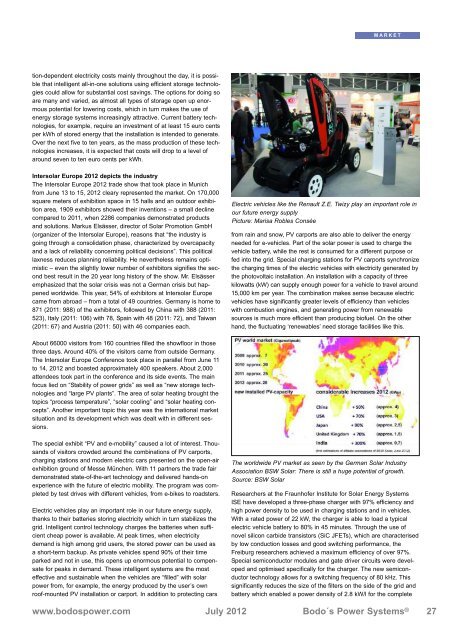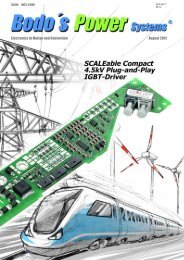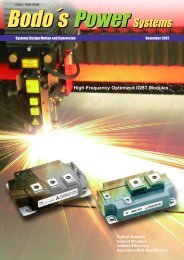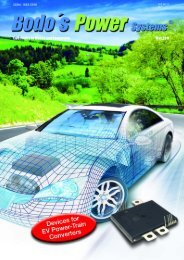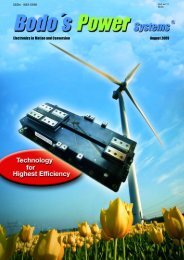Electronics in Motion and Conversion July 2012 - Bodo's Power
Electronics in Motion and Conversion July 2012 - Bodo's Power
Electronics in Motion and Conversion July 2012 - Bodo's Power
Create successful ePaper yourself
Turn your PDF publications into a flip-book with our unique Google optimized e-Paper software.
tion-dependent electricity costs ma<strong>in</strong>ly throughout the day, it is possible<br />
that <strong>in</strong>telligent all-<strong>in</strong>-one solutions us<strong>in</strong>g efficient storage technologies<br />
could allow for substantial cost sav<strong>in</strong>gs. The options for do<strong>in</strong>g so<br />
are many <strong>and</strong> varied, as almost all types of storage open up enormous<br />
potential for lower<strong>in</strong>g costs, which <strong>in</strong> turn makes the use of<br />
energy storage systems <strong>in</strong>creas<strong>in</strong>gly attractive. Current battery technologies,<br />
for example, require an <strong>in</strong>vestment of at least 15 euro cents<br />
per kWh of stored energy that the <strong>in</strong>stallation is <strong>in</strong>tended to generate.<br />
Over the next five to ten years, as the mass production of these technologies<br />
<strong>in</strong>creases, it is expected that costs will drop to a level of<br />
around seven to ten euro cents per kWh.<br />
Intersolar Europe <strong>2012</strong> depicts the <strong>in</strong>dustry<br />
The Intersolar Europe <strong>2012</strong> trade show that took place <strong>in</strong> Munich<br />
from June 13 to 15, <strong>2012</strong> cleary represented the market. On 170,000<br />
square meters of exhibition space <strong>in</strong> 15 halls <strong>and</strong> an outdoor exhibition<br />
area, 1909 exhibitors showed their <strong>in</strong>ventions – a small decl<strong>in</strong>e<br />
compared to 2011, when 2286 companies demonstrated products<br />
<strong>and</strong> solutions. Markus Elsässer, director of Solar Promotion GmbH<br />
(organizer of the Intersolar Europe), reasons that “the <strong>in</strong>dustry is<br />
go<strong>in</strong>g through a consolidation phase, characterized by overcapacity<br />
<strong>and</strong> a lack of reliability concern<strong>in</strong>g political decisions”. This political<br />
laxness reduces plann<strong>in</strong>g reliability. He nevertheless rema<strong>in</strong>s optimistic<br />
– even the slightly lower number of exhibitors signifies the second<br />
best result <strong>in</strong> the 20 year long history of the show. Mr. Elsässer<br />
emphasized that the solar crisis was not a German crisis but happened<br />
worldwide. This year, 54% of exhibitors at Intersolar Europe<br />
came from abroad – from a total of 49 countries. Germany is home to<br />
871 (2011: 988) of the exhibitors, followed by Ch<strong>in</strong>a with 388 (2011:<br />
523), Italy (2011: 106) with 78, Spa<strong>in</strong> with 48 (2011: 72), <strong>and</strong> Taiwan<br />
(2011: 67) <strong>and</strong> Austria (2011: 50) with 46 companies each.<br />
About 66000 visitors from 160 countries filled the showfloor <strong>in</strong> those<br />
three days. Around 40% of the visitors came from outside Germany.<br />
The Intersolar Europe Conference took place <strong>in</strong> parallel from June 11<br />
to 14, <strong>2012</strong> <strong>and</strong> boasted approximately 400 speakers. About 2,000<br />
attendees took part <strong>in</strong> the conference <strong>and</strong> its side events. The ma<strong>in</strong><br />
focus lied on “Stability of power grids” as well as “new storage technologies<br />
<strong>and</strong> “large PV plants”. The area of solar heat<strong>in</strong>g brought the<br />
topics “process temperature”, “solar cool<strong>in</strong>g” <strong>and</strong> “solar heat<strong>in</strong>g concepts”.<br />
Another important topic this year was the <strong>in</strong>ternational market<br />
situation <strong>and</strong> its development which was dealt with <strong>in</strong> different sessions.<br />
The special exhibit “PV <strong>and</strong> e-mobility” caused a lot of <strong>in</strong>terest. Thous<strong>and</strong>s<br />
of visitors crowded around the comb<strong>in</strong>ations of PV carports,<br />
charg<strong>in</strong>g stations <strong>and</strong> modern electric cars presented on the open-air<br />
exhibition ground of Messe München. With 11 partners the trade fair<br />
demonstrated state-of-the-art technology <strong>and</strong> delivered h<strong>and</strong>s-on<br />
experience with the future of electric mobility. The program was completed<br />
by test drives with different vehicles, from e-bikes to roadsters.<br />
Electric vehicles play an important role <strong>in</strong> our future energy supply,<br />
thanks to their batteries stor<strong>in</strong>g electricity which <strong>in</strong> turn stabilizes the<br />
grid. Intelligent control technology charges the batteries when sufficient<br />
cheap power is available. At peak times, when electricity<br />
dem<strong>and</strong> is high among grid users, the stored power can be used as<br />
a short-term backup. As private vehicles spend 90% of their time<br />
parked <strong>and</strong> not <strong>in</strong> use, this opens up enormous potential to compensate<br />
for peaks <strong>in</strong> dem<strong>and</strong>. These <strong>in</strong>telligent systems are the most<br />
effective <strong>and</strong> susta<strong>in</strong>able when the vehicles are “filled” with solar<br />
power from, for example, the energy produced by the user’s own<br />
roof-mounted PV <strong>in</strong>stallation or carport. In addition to protect<strong>in</strong>g cars<br />
MARKET<br />
Electric vehicles like the Renault Z.E. Twizy play an important role <strong>in</strong><br />
our future energy supply<br />
Picture: Marisa Robles Consée<br />
from ra<strong>in</strong> <strong>and</strong> snow, PV carports are also able to deliver the energy<br />
needed for e-vehicles. Part of the solar power is used to charge the<br />
vehicle battery, while the rest is consumed for a different purpose or<br />
fed <strong>in</strong>to the grid. Special charg<strong>in</strong>g stations for PV carports synchronize<br />
the charg<strong>in</strong>g times of the electric vehicles with electricity generated by<br />
the photovoltaic <strong>in</strong>stallation. An <strong>in</strong>stallation with a capacity of three<br />
kilowatts (kW) can supply enough power for a vehicle to travel around<br />
15,000 km per year. The comb<strong>in</strong>ation makes sense because electric<br />
vehicles have significantly greater levels of efficiency than vehicles<br />
with combustion eng<strong>in</strong>es, <strong>and</strong> generat<strong>in</strong>g power from renewable<br />
sources is much more efficient than produc<strong>in</strong>g biofuel. On the other<br />
h<strong>and</strong>, the fluctuat<strong>in</strong>g ‘renewables’ need storage facilities like this.<br />
The worldwide PV market as seen by the German Solar Industry<br />
Association BSW Solar: There is still a huge potential of growth.<br />
Source: BSW Solar<br />
Researchers at the Fraunhofer Institute for Solar Energy Systems<br />
ISE have developed a three-phase charger with 97% efficiency <strong>and</strong><br />
high power density to be used <strong>in</strong> charg<strong>in</strong>g stations <strong>and</strong> <strong>in</strong> vehicles.<br />
With a rated power of 22 kW, the charger is able to load a typical<br />
electric vehicle battery to 80% <strong>in</strong> 45 m<strong>in</strong>utes. Through the use of<br />
novel silicon carbide transistors (SiC JFETs), which are characterised<br />
by low conduction losses <strong>and</strong> good switch<strong>in</strong>g performance, the<br />
Freiburg researchers achieved a maximum efficiency of over 97%.<br />
Special semiconductor modules <strong>and</strong> gate driver circuits were developed<br />
<strong>and</strong> optimised specifically for the charger. The new semiconductor<br />
technology allows for a switch<strong>in</strong>g frequency of 80 kHz. This<br />
significantly reduces the size of the filters on the side of the grid <strong>and</strong><br />
battery which enabled a power density of 2.8 kW/l for the complete<br />
www.bodospower.com <strong>July</strong> <strong>2012</strong> Bodo´s <strong>Power</strong> Systems ®<br />
www.bodospower.com <strong>July</strong> <strong>2012</strong> Bodo´s <strong>Power</strong> Systems ®<br />
27


